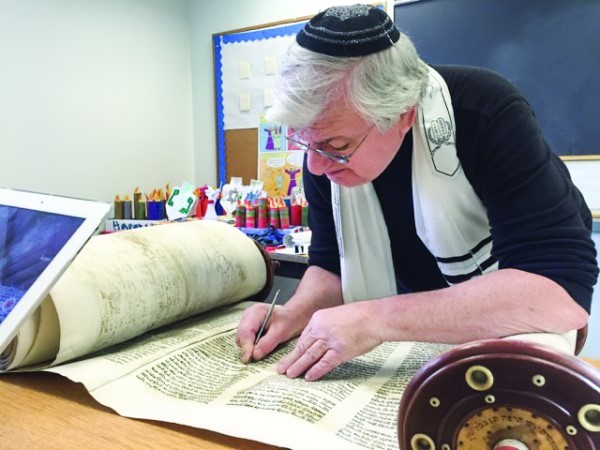Island congregation restores beloved Torah
In the early 1980s, a handful of Jewish residents of Block Island came together to realize a shared idea: to hold Sabbath and High Holy Day services.
Initially, they met informally at each other’s homes throughout the summer months, but then organized as Congregation Sons and Daughters of Ruth.
The group is fortunate to have two Torahs – a large one donated by the late Justin and Joan Abrams and their family, and a smaller one from the late Haida Ginsberg.
The Torah from the Abrams family has come to constitute a spiritual home for congregation members, especially since they have continued without a building. (For many years, St. Andrew Church has offered the congregation its Parish Center as a home for Shabbat and holiday services.)
The Abrams family has continued to care for and house the Torah, which is carefully taken out during the Jewish High Holy Days each autumn. The smaller Torah is used for weekly Shabbat services.
A mission of Torah rescue
Several months before he passed away, in March, Justin Abrams had suggested the Torah be repaired, and the congregants immediately took up the challenge.
The group located a sofer (Torah scribe), Neil Yerman, artist-in-residence at the Sinai Free Synagogue, in Mt. Vernon, New York. Yerman is a master of Hebrew calligraphy and document restoration, and is knowledgeable in the traditions governing the writing and restoration of Torah scrolls.
The immediate mission for members of the congregation became to escort the Torah to Yerman for evaluation, a process Justin Abrams and his family generously underwrote.
Full disclosure: This writer is a congregant and was half of the delegation designated to accompany the Torah to Mt. Vernon, along with congregation President Sherry Kandel.
So it was that on an afternoon in early December 2015, we met Yerman, an affable and outgoing man, who eagerly welcomed us to his studio at the Sinai Free Synagogue. For nearly two hours he explained the process of Torah creation and restoration and the methodical skills necessary when dealing with a holy scroll. In addition, he regaled us with anecdotes and tales illustrating the inspirational nature of his work: Yerman’s educational focus is aimed at nurturing not only a reverence for the physical Torah, but also a love of the wisdom embedded in the ancient letters.
He said each Torah is painstakingly handwritten, as Jewish law dictates. Consisting of 304,805 letters, it can take up to a year to create one Torah, at a cost of from $75,000 to $80,000.
Hebrew:
A compressed language
To begin the restoration process, the sofer must bring a “spiritual intention” to bear on his work. “It is an act of love, the love of the Lord,” Yerman says.
Speaking of Hebrew as “a compressed language, [with] an intense concentration of meaning inherent in the letters,” he says its roots go back to Greek, Aramaic and Phoenician.
Often while he works, Yerman admits he “sings the letters” to himself. He explains, “The commandment says, ‘Write the song,’ not the Torah.”
In attempting to write beautifully, which he sees as his charge, “we are actually performing the commandment to ‘love the Lord,’ and [consequently] love everything that comes of God,” he says.
By extension, Yerman believes everything is implicit in this line: “And therefore choose life.” He maintains that in all the relationships we have, “with family and friends, in all our undertakings – whether at prayer or work – when we attempt to write something, it should be done beautifully.” In this way we each of us expand creation, he feels.
Examining the island Torah
During his initial examination of the congregation’s Torah, Yerman explained it is between 80 and 90 years old and that it was made in Poland. The calligraphy, he says, “was written in the Bet Yoseph style with some hybrid elements [but] beautifully done.”
Though during a cursory examination most of the text seemed in good condition, the parchment appeared to be in a worrisome state, Yerman said. Over the years, a coating of calcium carbonate had built up – the result of residing in a very damp place, its island home.
Noting that the parchment was made of goatskin, Yerman indicated some tears along the edges of the scroll. As we looked at the wooden rollers, he noted that they needed repair, and the mantle required replacement.
Realizing we were entrusting our Torah to the kindest and most knowledgeable of hands, we left it with Yerman in his climate-controlled workshop at the Sinai Free Synagogue.
When he completed his examination a month later, we learned that the restoration would cost several thousand dollars.
The congregants agreed that restoring the Torah was both a pragmatic and spiritual investment – and we felt a moral obligation to do so.
As a result, over these past months we mounted a fundraiser. By July, we had reached our goal of $4,000. We are very grateful for the outpouring of contributions and moral support, and hopeful that the restoration will be completed in time to dedicate the Torah and use it during the High Holy Days.
GLORIA S. REDLICH is secretary of Congregation Sons and Daughters of Ruth and a reporter for The Block Island Times. She can be reached at gloryb311@gmail.com.








